
|
They say the only time you should look back is to see how far you've come, but that isn't necessarily the case in the job market. From a survey of just over 1,000 employed Americans, we'll examine both manager and employee perceptions of rejoining a company that a worker once left: Under what circumstances, if any, do respondents believe it is appropriate to rehire a former employee? We'll also evaluate possible motives for bringing someone back and the benefits doing so may offer to companies. Also, the circumstances of the rehiring process and employee satisfaction upon returning will be discussed. Read on to learn more about the ebb and flow of employees in the workplace.
Regarding the appropriateness of rehiring an employee, the most agreed-upon thought was that it was a moderately good idea; whereas just over a quarter were only slightly on board, a fifth were very in favor of it, and the rest were either extremely or not at all supportive of the idea. Baby boomers and older folks thought rehiring a former employee was very appropriate, whereas younger generations were much more on the fence about it, especially Gen Zers. Throughout different job levels, moderate acceptance was the most agreed-upon sentiment regarding employee rehiring as well.
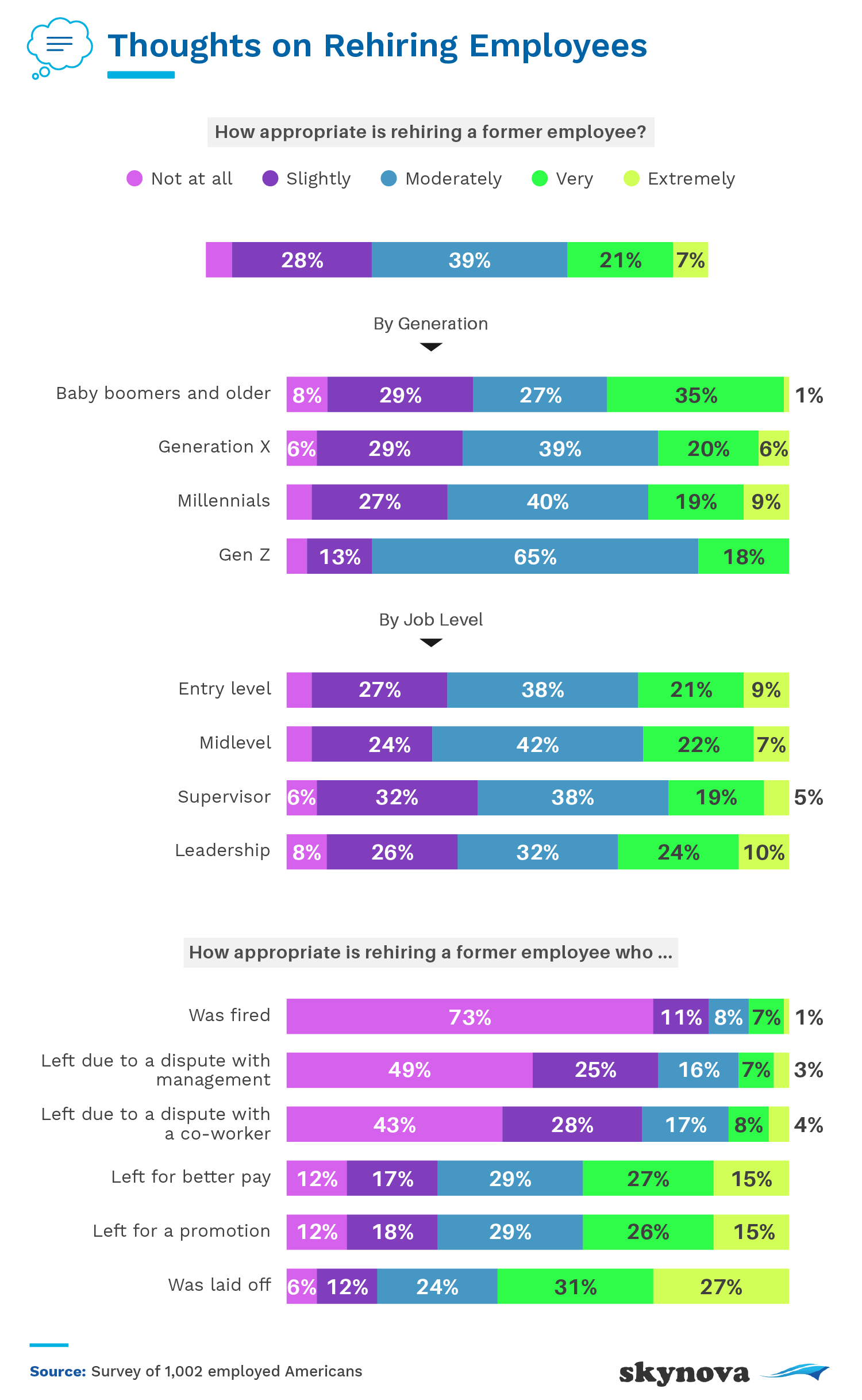
Regarding the terms on which an employee originally left the company, nearly three-quarters of respondents thought it wouldn't be at all appropriate to bring back a worker who had been fired, and many felt the same way if the employee in question had a previous dispute with management or a co-worker. The most acceptable reason to rehire an employee was if they had been laid off. Seeing as 225 million people around the world lost their jobs last year due to the global pandemic, rehiring them when companies financially recover is a no-brainer.
Sometimes, there are benefits to rehiring an employee. According to our respondents, the two big ones are that the hiring team already knows the quality of the candidate's work, as well as how effectively they integrate with their fellow employees. The hiring process is also more efficient because less time needs to be spent on training and fewer resources are required to vet new candidates.
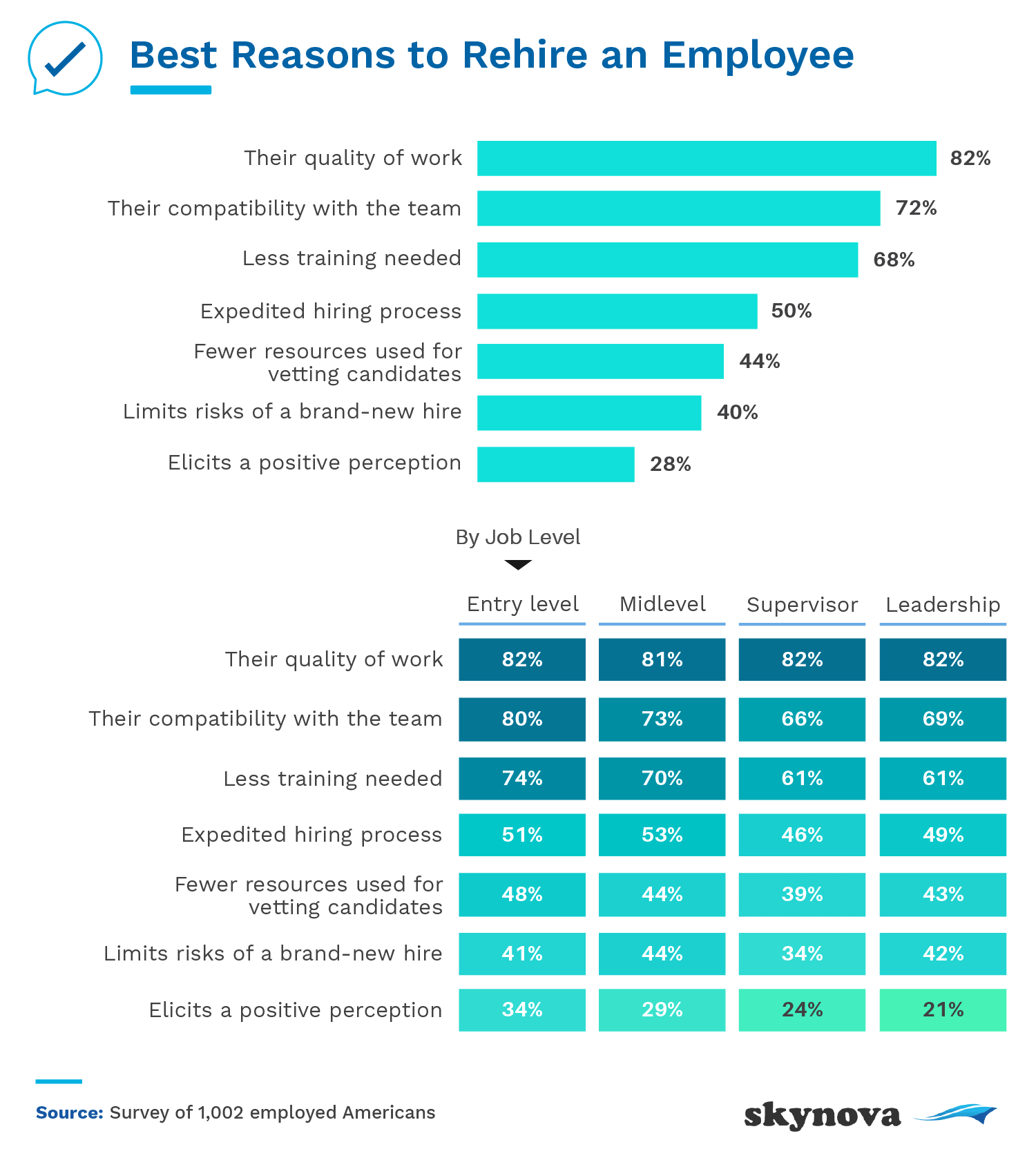
Regardless of job level, our respondents said that knowledge of an employee's past quality of work was the biggest incentive for rehiring. Rehiring an employee may have its cons though – the worker may hold a grudge from their original release, they may be entitled or stubborn, or they simply might not be the best candidate for the job anymore.
Of the managers we surveyed, over a third said they had rehired a former employee. It's important to note that 87% of these employees originally left by their own free will. The majority of them were gone anywhere between six months and two years before returning, whereas 17% were back before the six-month mark, and 10% were away for more than two years before rejoining the company.
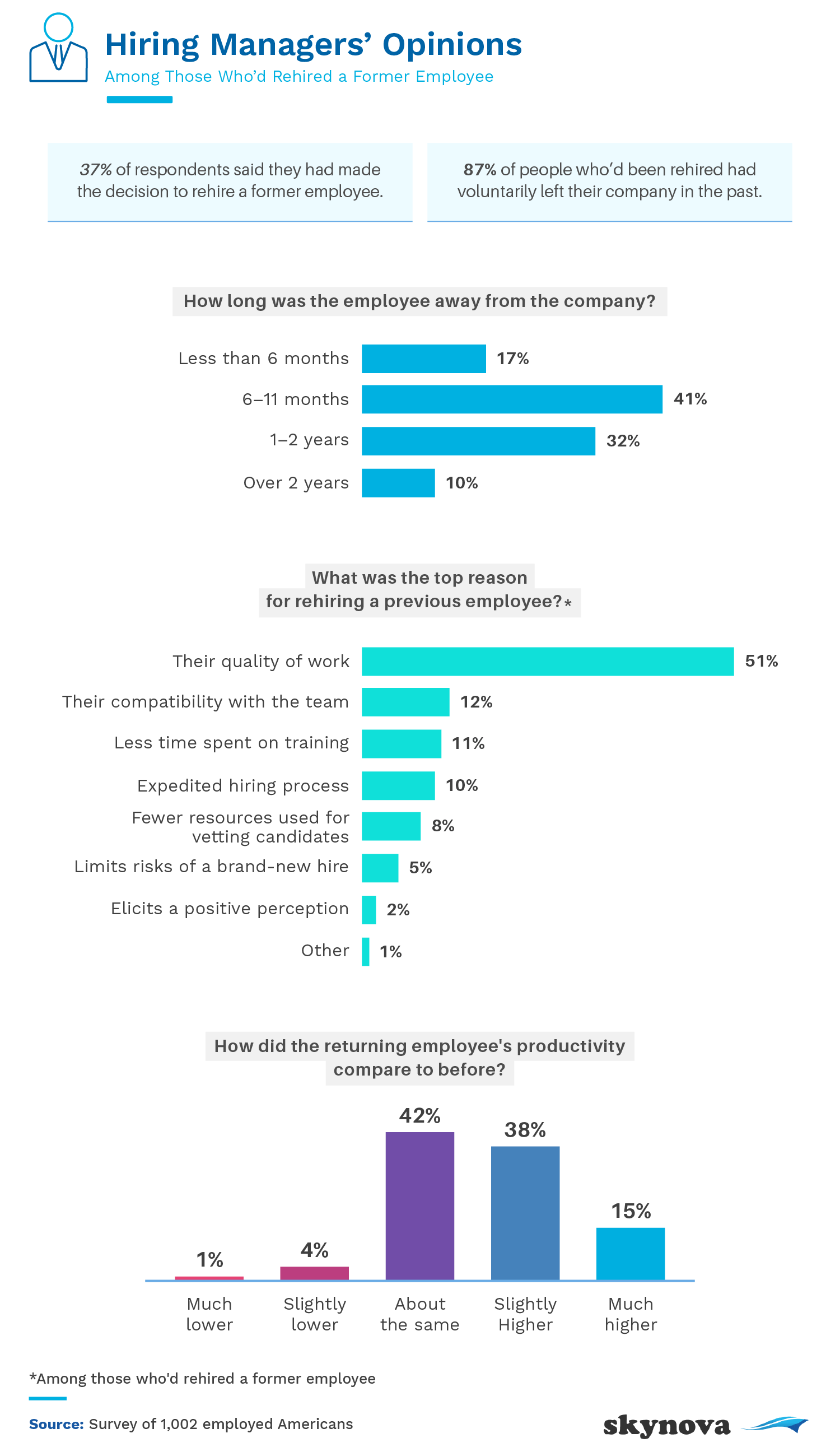
The most important reason for rehiring a previous employee, by far, was management's knowledge of their quality of work. Seeing as most of them chose to walk out, it's likely that they were performing adequately at the very least (seeing as they hadn't been fired). Upon returning, 42% of employees performed similarly to their previous time at the company, while 38% were slightly more productive, and 15% reset the bar in terms of productivity. There were hardly any cases of underwhelming employee performances upon returning.
"Boomerang" employees are a safe pick for employers looking to get the same output and quality of work, but studies have shown that both internal and external hires generally improve more over time than rehires do.
Thirty-seven percent of respondents said they had been rehired by a previous employer, and the vast majority had originally left voluntarily. Just over a quarter were gone for less than six months, 35% worked elsewhere from six months to less than a year, and the rest took their talents elsewhere for a year or more. There was almost an exact split regarding rehiring circumstances, with just over half reapplying for the job and the other half being sought out by the company.
Boomerang employees are encouraged to be more formal and reserved upon returning to show that they've grown, to offer fresh perspectives based on what they've learned while away, and to take the necessary time to get reacquainted with the company.
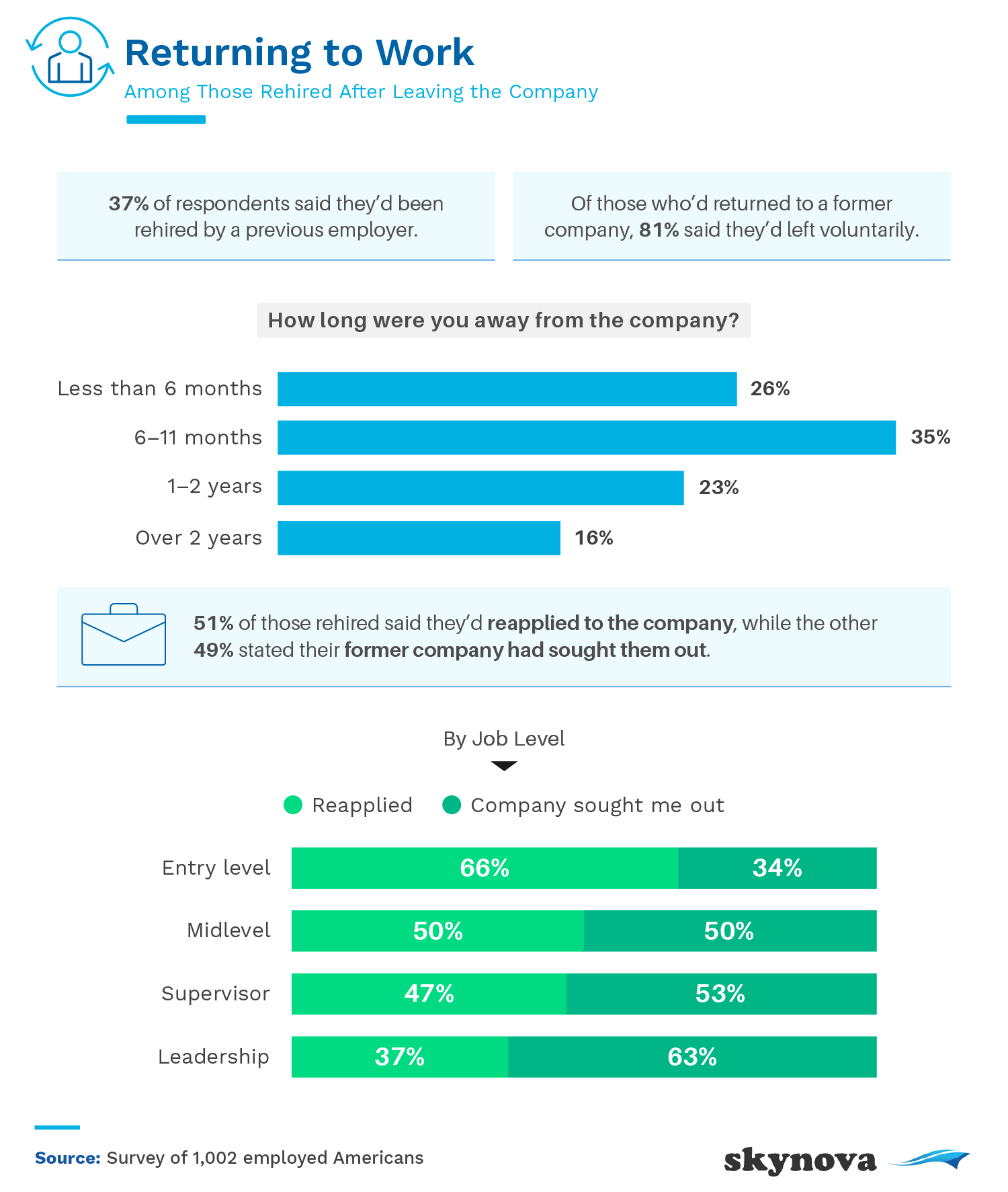
By job level, the higher the position, the more often it happened that the company reached out to the employee rather than the employee reapplying for the job themselves.
Employees have different reasons for coming back to a company they once left, but the most common incentive was better pay. When comparing reasoning by gender, men were much more influenced by salary than women were, while other motives were equally important to both sexes. In fact, a primary reason why men leave their jobs is to search for higher salaries elsewhere – those returning to their original posts apparently didn't have much luck in doing so.
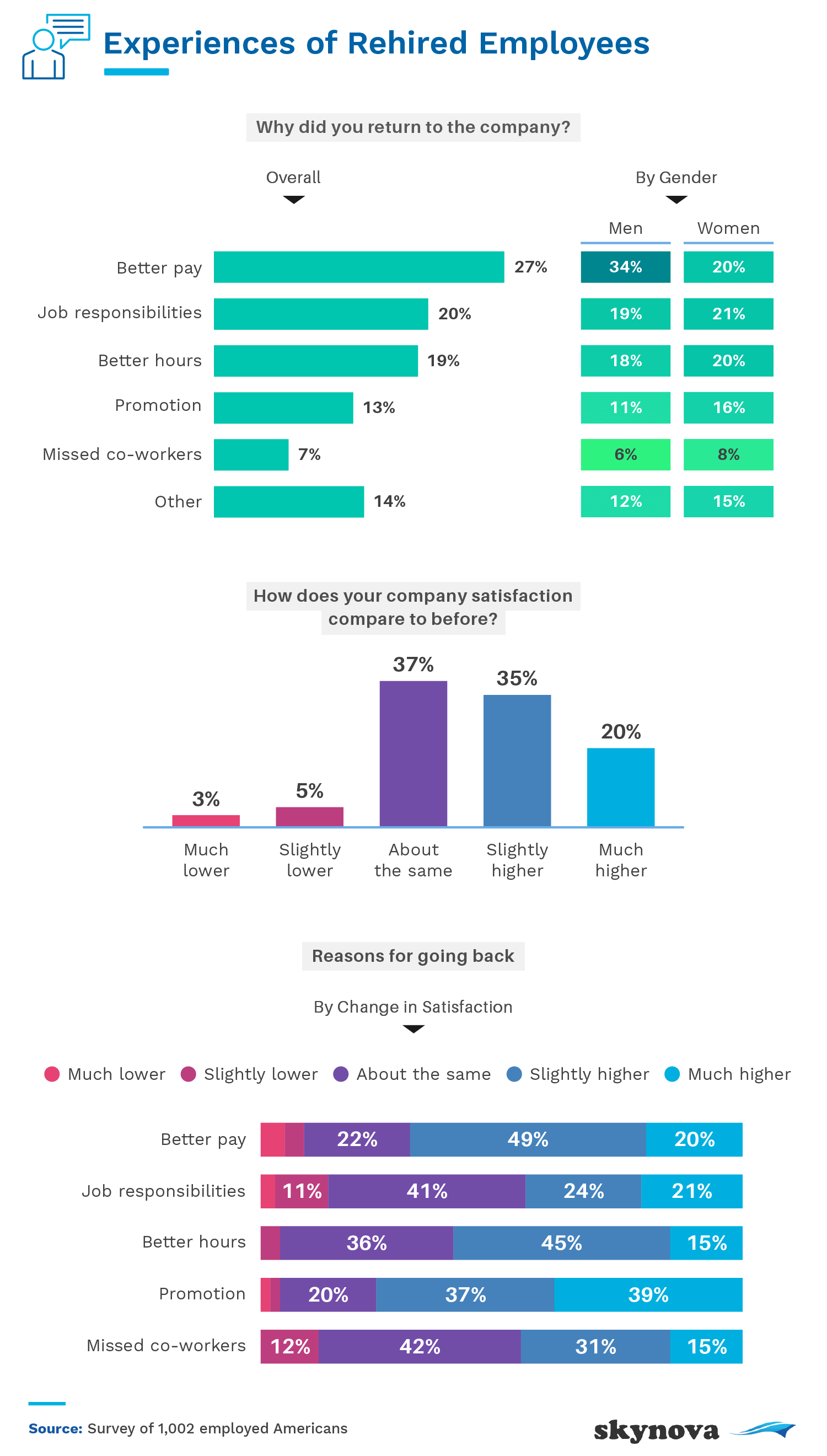
Upon returning, 37% of respondents reported their satisfaction level was about the same as it was during their last tenure. Thirty-five percent said it was slightly better, and 20% said they were much more satisfied with their experience. Only a handful of people had a worse time when they came back. Those who came back due to higher pay and more favorable hours were most likely to be slightly more satisfied with their job, while employees who came back for a promotion were predictably the happiest with their new situation.
Generally, there are certain circumstances in which rehiring an employee is acceptable, and others where it is not. An employee that had been previously fired (potentially due to a spat with management or a co-worker) should not be invited back to the company; but someone who was laid off (during the COVID-19 pandemic, for example) should typically be welcomed back. Having left an employer voluntarily, without burning any bridges, seems to be the easiest way to return if desired or to be sought out. Even with a desirable company culture, enticing an employee to return seems easiest by offering better pay.
Rehiring an employee has its benefits, with one of the biggest being that upper management already has a good idea of their quality of work and compatibility with other co-workers. Companies can also save on training costs and additional resources that would usually be used for new employees. That being said, rehiring an employee won't necessarily lead to increased productivity. In the end, companies will bring in new or old talent to suit their needs, however they see fit.
For all the online invoicing needs of small businesses, Skynova has you covered – our 37 software modules are designed to work together to provide a seamless and organized experience. We also enjoy writing about different business-related topics, many of which intersect with other areas of society, from technology to sports and politics. We use both primary and secondary research to create these articles in order to produce insightful and engaging content for the public to enjoy.
We collected 1,002 responses from employed Americans using the Amazon Mechanical Turk survey platform. 53% of our participants identified as men, 46% identified as women, and roughly 1% identified as nonbinary or nonconforming. Participants ranged in age from 18 to 79 with a mean of 39 and a standard deviation of 11. Those who reported no current employment or who failed an attention-check question were disqualified.
The sample size of respondents in leadership-level positions was 89 people. It is possible that with more leadership-level participants, we could have gained more insight into this population who likely have the final say in who is hired.
The data we are presenting rely on self-report. There are many issues with self-reported data. These issues include, but are not limited to, selective memory, telescoping, attribution, and exaggeration.
If you know any boomerang employees or anyone who might enjoy this article, feel free to send it their way. We just ask that you do so for noncommercial use only and to provide a link back to this page so they have access to our full findings and methodology.